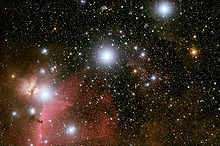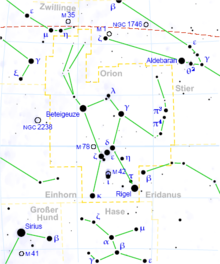Orion's Belt
Orion's Belt is a conspicuous row of stars in the middle of the constellation Orion, formed by the belt stars Mintaka (δ Ori), Alnilam (ε Ori), and Alnitak (ζ Ori). Their stellar words are close to the celestial equator (→ equatorial coordinate system).
These three bright stars of second magnitude are apparently close to each other at a distance of about 1°. They can be joined together in the imagination to form a row on an imaginary, almost straight line. Conceived as stars of a belt, their names go back to medieval Arab astronomy.
The star in the middle of the belt, Alnilam or Epsilon Orionis (ε Ori), has the fourth strongest apparent magnitude in Orion after Rigel (β Ori) and Betelgeuse (α Ori) as first magnitude stars and Bellatrix (γ Ori), but a considerably greater distance than these from the Sun. It is also even farther away than the slightly fainter outer stars of Orion's belt, Mintaka or Delta Orionis (δ Ori) to the west (or right) and Alnitak or Zeta Orionis (ζ Ori) to the east (or left). These two, together with well over a hundred much fainter stars of similar age, belong to an open cluster about 800-900 light-years away: Collinder 70, whose apparent magnitude is about 3°.
In the vicinity of the Orion Belt, various zones of star formation of the Milky Way, which belong to the Orion Complex, are observable at a distance of about 1500 light-years. These include the Flame Nebula and the Horsehead Nebula, as well as the Orion Nebula (M 42) further south (or below) in the so-called "Sword Necklace".
With the stars connected to form the belt as an auxiliary line, the brightest star can be found at about six times the extension to the left, Sirius (α CMa) in the constellation of the Great Dog; to the right, at about a similar distance, is Aldebaran (α Tau) in the constellation of Taurus.
.jpg)
Map of the constellation of Orion with background depiction of the hunter Orion of Greek mythology (London, 1825), Orion's belt blue.

Constellation Orion with the three belt stars δ, ε and ζ

The three belt stars in Orion: Mintaka (δ Ori) on the right, Alnilam (ε Ori) in the middle, Alnitak (ζ Ori) on the left - next to it the Flame Nebula as well as below it the Horsehead Nebula and also σ Ori.
Naming and cultural reception
The constellation Orion is named after the hunter Orion of Greek mythology, a name commonly used in Western culture and professional astronomy. When the constellation is backed with a pictorial representation of the hunter, the stars of Orion's belt mark the belt of his clothing.
In medieval Europe, the row of these three stars was also called Jacob's staff or Jacob's ladder.
In Spain, Portugal and South America as a Catholic cultural area, the name Tres Marías or Três Marias ("Three Marys") is also common.
Location and appearance
Bordering the constellation Orion are the constellations Gemini, Taurus, River Eridanus, Lepus and Monoceros. The latter three are closest to Orion's belt.
The prominent constellation of belt stars in Orion has a position very close to the celestial equator - the amounts of declination are below 2°. Therefore, for observers on Earth, except in the areas near the poles, the belt stars are completely above the horizon for just under twelve hours every day. In the evening starry sky they are easily observable in the last and first quarter of the year, i.e. in Central Europe from late autumn until the beginning of spring.
Alnilam, the middle one, is apparently and also absolutely the brightest of the three belt stars. In terms of its spherical coordinates, it lies almost exactly midway between the asterisms of the outer two. The western belt star Mintaka (the right one for observers in the northern hemisphere) lies only ¼ degree south of the celestial equator; due to the precession of the Earth's axis, this angle temporarily becomes zero around the year 2080.
For observers in central European latitudes, the line of the Orion belt appears approximately perpendicular to the horizon at its rising and nearly parallel to the horizon at its setting.
| Belt stars (with FK5 coordinates (right ascension, declination 2000.0) and apparent magnitude) | ||||
| Name | Right ascension | Declination | Brightness | Comment |
| Mintaka (δ Ori) | 5h 32m 0,4s | 1998243.3−0° 17′ 56.7″ | 2.2 mag | |
| Alnilam (ε Ori) | 5h 36m 12,81s | 1988793.1−1° 12′ 6.9″ | 1.69 mag | between Mintaka and Alnitak about 0.07° south of centre (536235h 36m 23s, 1989285-1° 7′ 15″) |
| Alnitak (ζ Ori) | 5h 40m 45,53s | 1984365.735−1° 56′ 34.265″ | 2,03 mag | |

Orion and adjacent constellations - the belt stars lie almost on the celestial equator
Search within the encyclopedia